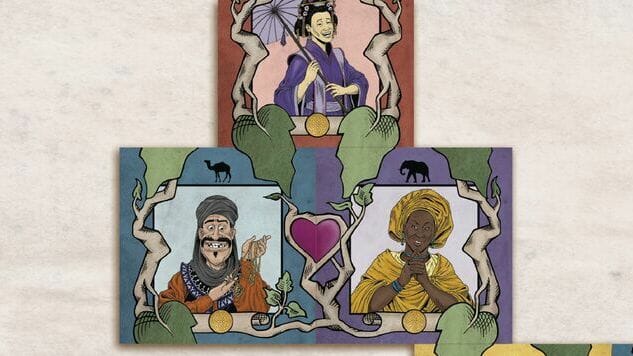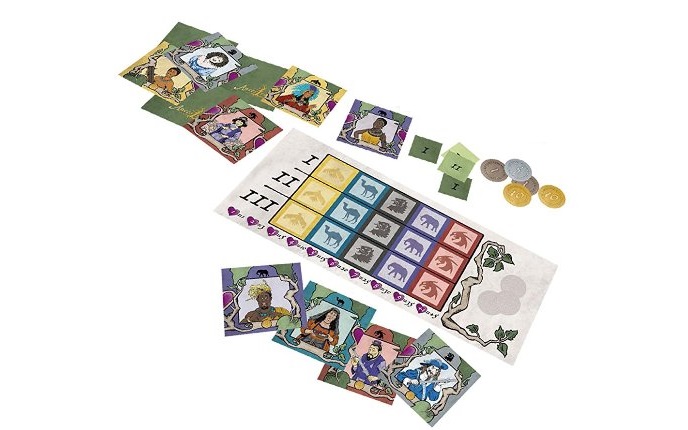Board Game Ancestree Plays Too Much Like Its Ancestors
Art courtesy of Calliope Games Games Reviews board games
Ancestree comes from Calliope Games’ Titan series, where experienced designers of heavier games offer lightweight designs for quick-playing games more in line with Calliope’s other titles. Its designer, Eric Lang, is best known for 2015’s Blood Rage, a medium-heavy game of dudes on a map with miniatures and a fantasy theme and card drafting and hand management and, yeah, it’s kind of a lot, so Ancestree’s short rule set and quick playing time is a pleasant surprise. It’s a nice filler game, but there’s a little too much here that’s familiar to any regular board gamers.
Ancestree’s gimmick is to have players build family trees of tiles that come in five colors and may have zero, one or two connecting branches on the top and on the bottom of each tile, allowing you to connect them to tiles on additional rows on your tableau. Some tiles also have half-hearts on one or both sides of the tile, allowing you to create ‘marriages’ by forming complete hearts with two adjacent tiles. You may only place a tile if you can connect a branch (top to bottom) or complete a heart (left to right).
The game takes place over three rounds, with players placing fifteen tiles each over the entire game. In a round, each player takes six face-down tiles at random from the general supply, then plays one to his/her family tree and passes the remaining tiles to the player to the left (rounds 1/3) or right (round 2). Players continue to place and pass until everyone has placed five tiles in the round, at which point the last tiles are discarded and the end-of-round scoring takes place.
At the end of each round, you compare your longest family line in each of the five colors to those of your neighbors to the left and to the right, and score 1, 2 or 3 points (depending on the round) if your line is longer. A family line must be connected vertically, and you count one tile in each color per row (“generations” in the game’s parlance). With five colors and two neighbors, you make ten comparisons in each round, 30 over the course of the game, and it’s really hard for anyone to run away with this aspect of the scoring. You’ll often end up with ties in several colors, where no one scores, especially after the first round, but by game-end every player should have 15 tiles in his/her family tree and there will be plenty of differences between neighboring players.

The final scoring is generally dominated by the scoring of marriages; whenever we’ve played, the player who completed the most marriages on his/her tree won the game, with those points accounting for just over a third of their final scores. It seems like you can punt a little bit on the round scoring—at least by ignoring one or two of the colors—if you’re sufficiently bulking up on marriages. The first three marriages are worth just five points in total, but each one after that is worth an additional five points, and in my plays it seems like getting at least seven marriages (25 points) is key to winning the game.
If a lot of this sounds familiar to you, it should be, as the tile-drafting mechanism and the scoring at the end of each of the three rounds are both identical to the structure of 7 Wonders, where players pass around hands of seven cards (take one, pass the rest, discard the last card at the end of each round), and military scoring takes place three times, comparing you to your immediate neighbors, with points increasing as the game progresses. It’s not very original, and as with 7 Wonders, it’s problematic with fewer than four players.
And then there’s the artwork, which I might politely describe as Crone Chic. These are not people you want in your living room, let alone your family, and players are going to love this artwork or hate it, with very few in between. It’s a peculiar direction for a game that, by its rule set, seems to be aimed at beginning gamers or for families looking to add to their game nights. I demoed this at GenCon last year and my first impression was quite positive, but after several more plays it became clear that Ancestree doesn’t offer anything I haven’t already seen before—and with illustrations that might give me nightmares, too.
Keith Law is a senior baseball writer for ESPN.com and an analyst on ESPN’s Baseball Tonight. You can read his baseball content at search.espn.go.com/keith-law and his personal blog the dish, covering games, literature, and more, at meadowparty.com/blog.